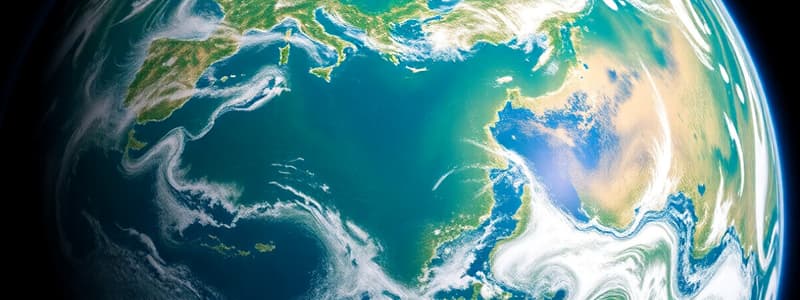Podcast
Questions and Answers
What process describes the change of a solid directly into gas without becoming liquid?
What process describes the change of a solid directly into gas without becoming liquid?
- Condensation
- Sublimation (correct)
- Transpiration
- Evaporation
Which of the following is NOT a layer of the geosphere?
Which of the following is NOT a layer of the geosphere?
- Atmosphere (correct)
- Mantle
- Crust
- Core
Which layer of the geosphere is defined as the outermost solid shell of the Earth?
Which layer of the geosphere is defined as the outermost solid shell of the Earth?
- Lithosphere
- Core
- Crust (correct)
- Mantle
What term describes the non-living components of an ecosystem?
What term describes the non-living components of an ecosystem?
What is the primary function of a niche in an ecosystem?
What is the primary function of a niche in an ecosystem?
Which component of the biosphere encompasses all ecosystems on Earth?
Which component of the biosphere encompasses all ecosystems on Earth?
Which of the following types of rocks is formed through cooling and solidification of magma or lava?
Which of the following types of rocks is formed through cooling and solidification of magma or lava?
What part of the Earth system does the cryosphere pertain to?
What part of the Earth system does the cryosphere pertain to?
What gas makes up the largest percentage of the Earth's atmosphere?
What gas makes up the largest percentage of the Earth's atmosphere?
In which atmospheric layer does most weather occur?
In which atmospheric layer does most weather occur?
Which layer of the atmosphere is directly above the stratosphere?
Which layer of the atmosphere is directly above the stratosphere?
What is the process of water vapor turning into liquid called?
What is the process of water vapor turning into liquid called?
What does the term 'hydrosphere' refer to?
What does the term 'hydrosphere' refer to?
At what altitude does the mesosphere extend to?
At what altitude does the mesosphere extend to?
Which atmospheric layer is known for its relative lack of turbulence and storm activity?
Which atmospheric layer is known for its relative lack of turbulence and storm activity?
What is the primary function of the ozone layer?
What is the primary function of the ozone layer?
Flashcards are hidden until you start studying
Study Notes
Subsystems of the Earth
- Earth consists of four main subsystems: Atmosphere, Hydrosphere, Geosphere, and Biosphere, with an additional subsystem known as the Cryosphere.
Atmosphere
- A thin layer of gases and particles surrounding Earth, primarily composed of:
- 78% Nitrogen (N)
- 21% Oxygen (O)
- 0.9% Argon (Ar)
- 0.1% other gases, including Carbon Dioxide (CO2), Methane (CH4), Water vapor (H2O), and Neon (Ne).
Layers of the Atmosphere
- Exosphere: Outermost layer, representing the edge of the atmosphere.
- Thermosphere: Located above the Mesosphere, below the Exosphere, characterized by high temperatures.
- Mesosphere: Extends from about 50 to 85 km (31 to 53 miles) above Earth, directly above the Stratosphere.
- Stratosphere: Contains distinct layers, stabilized air with cold, heavy air at the bottom and warmer, lighter air above; no storms or turbulence.
- Troposphere: Lowest layer where most clouds and weather phenomena occur.
Ozone Layer
- The ozone layer is found within the Stratosphere and protects living organisms from harmful ultraviolet radiation from the sun.
Karman Line
- Defines the boundary between Earth's atmosphere and outer space.
Hydrosphere
- Represents the total water on Earth, existing as liquid, vapor, or ice, encompassing surface water, underground water, and atmospheric water.
Water Cycle Processes
- Evaporation: Process of liquid water turning into vapor.
- Condensation: Conversion of vapor or gas back into liquid.
- Precipitation: Water released from clouds as rain, hail, or snow.
- Transpiration: Evaporation of water from plant surfaces.
- Sublimation: Process where a solid turns directly into gas without becoming liquid.
Geosphere
- Composed of the Earth's rocks, minerals, and landforms, it can be divided into three layers:
- Crust: The thinnest outermost layer of rock.
- Mantle: Thickest layer, extends approximately 2,900 kilometers below the crust.
- Core: Central part of Earth, consisting of a solid inner core and a liquid outer core.
Types of Rocks
- Three primary types of rocks:
- Igneous rocks
- Sedimentary rocks
- Metamorphic rocks
Biosphere
- Comprises all ecosystems and regions on Earth where life exists, termed the zonal life area.
Ecosystem Components
- Biotic Components: Living organisms within an ecosystem.
- Abiotic Components: Non-living environmental factors.
Niche in Ecosystem
- The niche describes the unique role or function of an organism within its community.
Cryosphere
- Represents the frozen water parts of Earth, including ice-covered regions in Antarctica and the Arctic.
Studying That Suits You
Use AI to generate personalized quizzes and flashcards to suit your learning preferences.




